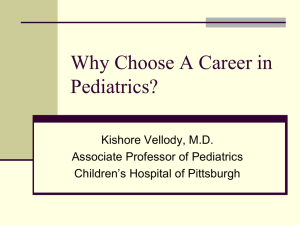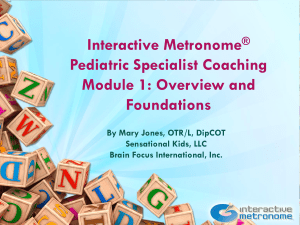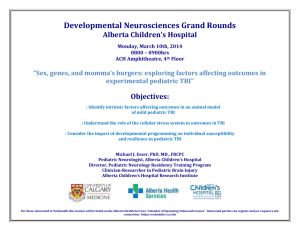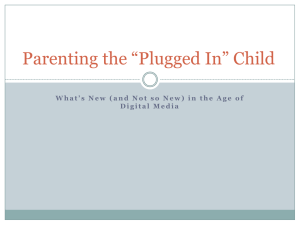In Pediatrics - Funandeducation.org
advertisement
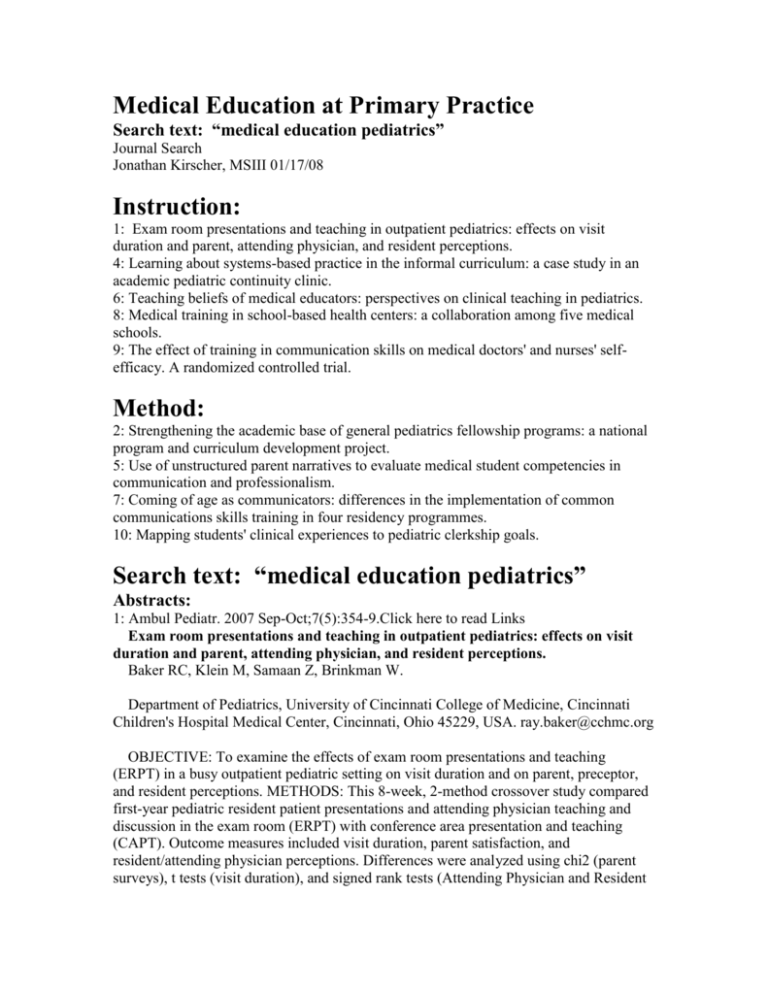
Medical Education at Primary Practice
Search text: “medical education pediatrics”
Journal Search
Jonathan Kirscher, MSIII 01/17/08
Instruction:
1: Exam room presentations and teaching in outpatient pediatrics: effects on visit
duration and parent, attending physician, and resident perceptions.
4: Learning about systems-based practice in the informal curriculum: a case study in an
academic pediatric continuity clinic.
6: Teaching beliefs of medical educators: perspectives on clinical teaching in pediatrics.
8: Medical training in school-based health centers: a collaboration among five medical
schools.
9: The effect of training in communication skills on medical doctors' and nurses' selfefficacy. A randomized controlled trial.
Method:
2: Strengthening the academic base of general pediatrics fellowship programs: a national
program and curriculum development project.
5: Use of unstructured parent narratives to evaluate medical student competencies in
communication and professionalism.
7: Coming of age as communicators: differences in the implementation of common
communications skills training in four residency programmes.
10: Mapping students' clinical experiences to pediatric clerkship goals.
Search text: “medical education pediatrics”
Abstracts:
1: Ambul Pediatr. 2007 Sep-Oct;7(5):354-9.Click here to read Links
Exam room presentations and teaching in outpatient pediatrics: effects on visit
duration and parent, attending physician, and resident perceptions.
Baker RC, Klein M, Samaan Z, Brinkman W.
Department of Pediatrics, University of Cincinnati College of Medicine, Cincinnati
Children's Hospital Medical Center, Cincinnati, Ohio 45229, USA. ray.baker@cchmc.org
OBJECTIVE: To examine the effects of exam room presentations and teaching
(ERPT) in a busy outpatient pediatric setting on visit duration and on parent, preceptor,
and resident perceptions. METHODS: This 8-week, 2-method crossover study compared
first-year pediatric resident patient presentations and attending physician teaching and
discussion in the exam room (ERPT) with conference area presentation and teaching
(CAPT). Outcome measures included visit duration, parent satisfaction, and
resident/attending physician perceptions. Differences were analyzed using chi2 (parent
surveys), t tests (visit duration), and signed rank tests (Attending Physician and Resident
Surveys). RESULTS: Three hundred forty patient encounters were studied (151 ERPT vs
189 CAPT) that involved 15 first-year pediatric residents and 15 attending physicians.
Visit durations were equivalent. Parent satisfaction was high in both methods. Attending
physicians favored ERPT for adding opportunities to evaluate resident competencies,
provide informed feedback, and role model. Attending physicians felt that ERPT
decreased resident comfort level when discussing sensitive topics. Residents were less
comfortable with ERPT for discussing sensitive topics and felt somewhat embarrassed
when they did not know the answer to attending physicians' questions. Residents reported
that ERPT presentations permitted attending physicians to demonstrate more physical
exam skills and to observe interactions, enabling more informed feedback.
CONCLUSIONS: ERPT and CAPT require similar time and result in high parent
satisfaction. Although residents are a little less comfortable with ERPT, attending
physicians are better able to observe, evaluate, and give feedback on resident skills and to
role model and teach physical diagnosis.
PMID: 17870643 [PubMed - indexed for MEDLINE]
2: Ambul Pediatr. 2007 Sep-Oct;7(5):340-7.
Strengthening the academic base of general pediatrics fellowship programs: a
national program and curriculum development project.
Baldwin CD, Szilagyi PG, Dreyer BP, Bell LM, Baker RC, Cheng TL, Coury DL,
DeWitt TG, Darden PM, Duggan A, Ludwig S.
Department of Pediatrics, University of Rochester School of Medicine and Dentistry,
Rochester, NY 14642, USA. constance_baldwin@urmc.rochester.edu
OBJECTIVE: To improve academic general pediatrics (AGP) fellowship programs by
1) developing curriculum guidelines and program standards and 2) creating a process for
program review and consultation that might later be used for accreditation of AGP
fellowship programs. METHODS: This project of the Ambulatory Pediatric Association
(APA) created 4 documents: AGP fellowship program requirements, core
curriculum, educational goals and objectives, and a standardized form to describe
required program characteristics. Site visits were conducted at 7 volunteer AGP
fellowship programs, selected for diversity of content, structure, and location.
Evaluations were conducted using a uniform checklist of requirements that combined
numerical ratings with a written evaluation summary. Feedback from programs on the
review process enabled refinement of the documents. RESULTS: The site visits revealed
great variety in emphasis among the 7 programs. In general, faculty were dedicated and
capable, and programs showed considerable educational strengths. Typical problems
were lack of integration of the program within departmental structures,
overburdened faculty, and uncertain funding. Many programs demonstrated suboptimal
curriculum planning and weak evaluation methods. Most program leaders felt that the
project materials helped to improve the quality of their programs, and 5 of 7 programs
expressed willingness to be involved in formal accreditation review in the future.
CONCLUSIONS: AGP fellowship programs that volunteered for piloting of an
accreditation process were diverse and vital, with rich educational offerings despite a lack
of optimal curriculum structure, minimal evaluation, limited faculty resources, and
tenuous funding. An APA accreditation process appears to be feasible and may enhance
AGP fellowship programs.
PMID: 17870641 [PubMed - indexed for MEDLINE]
3: Ambul Pediatr. 2007 Sep-Oct;7(5):328-39.
Academic general pediatric fellowships: curriculum design and educational goals
and objectives.
Baldwin CD, Dreyer BP, Szilagyi PG, Bell LM, Baker RC, Cheng TL, Coury DL,
DeWitt TG, Darden PM, Duggan A, Ludwig S.
Department of Pediatrics, University of Rochester School of Medicine and Dentistry,
Rochester, NY 14642, USA. constance_baldwin@urmc.rochester.edu
Academic generalists are unique and important members of the pediatric landscape.(1)
Academic general pediatrics (AGP) is not considered a subspecialty, because it adheres
to generalist values and embraces a wide range of clinical activities. Nonetheless,
academic generalists engage in important scholarly efforts, contribute extensively to the
education of new pediatricians, and must be prepared to survive in academia. Academic
general pediatric faculty positions are subject to the same appointment and promotion
requirements as those of subspecialist faculty.
4: Ambul Pediatr. 2007 May-Jun;7(3):214-9.
Learning about systems-based practice in the informal curriculum: a case study
in an academic pediatric continuity clinic.
Balmer D, Ruzek S, Ludwig S, Giardino AP.
Department of Pediatrics, The Children's Hospital of Philadelphia, Philadelphia, PA
19104, USA. balmer@email.chop.edu
OBJECTIVE: Pediatric residents learn about systems-based practice (SBP) explicitly
in the formal curriculum and implicitly in the informal curriculum as they engage in
practice alongside physician faculty. Recent studies describe innovative ways to address
SBP in the formal curriculum for SBP, but the informal curriculum has not been
explored. We examined what, and how, third-year pediatric residents learn about SBP in
the informal curriculum at one continuity clinic, and to consider how this learning aligns
with the formal curriculum. METHODS: A case study involving 10 third-year pediatric
residents and 10 continuity preceptors was conducted at one continuity clinic, housed in a
community-based, pediatric primary care center. Data were derived from 5 months (100
hours) of direct observation in the precepting room at the case clinic, semistructured
interviews with residents (before and after observation) and with preceptors (after
observation). Interview transcripts and notes from observation were inductively coded
and analyzed for major themes. RESULTS: Two themes emerged in the informal
curriculum. Residents perceived "our system," the academic health system in which they
trained and practiced as separate and distinct from the "real system," the larger, societal
context of health care. Residents also understood SBP as a commitment to helping
individual patients and families navigate the complexities of "our system," dealing with
issues that concerned them. CONCLUSIONS: Residents learn important lessons about
SBP in the informal curriculum in continuity clinic. These lessons may reinforce some
elements of the competency-based formal curriculum for SBP, but challenge others.
5. Ambul Pediatr. 2007 May-Jun;7(3):207-13.
Comment in:
Ambul Pediatr. 2007 May-Jun;7(3):203-4.
Use of unstructured parent narratives to evaluate medical student competencies
in communication and professionalism.
Liu GC, Harris MA, Keyton SA, Frankel RM.
Department of Pediatrics, Indiana University School of Medicine, Roudebush VAMC,
Indianapolis, Indiana, USA. gcliu@iupui.edu
OBJECTIVE: Medical education programs across the country are now required to
conduct meaningful assessments of trainees' competencies, although uniform standards
for conducting these evaluations have yet to be established. In 1999, the Indiana
University School of Medicine introduced a comprehensive competency-based
undergraduate curriculum. The overall goal of the curriculum is to make medical
students' day-to-day experiences of training a source of learning about professionalism,
communication, and aspects of medicine beyond factual knowledge. We sought to
examine free-text comments by parents of pediatric inpatients as substrate for
competency evaluation and feedback for third-year students on their pediatrics rotation.
METHODS: The study was conducted from June 2001 to February 2004. Parents of
hospitalized children completed a short medical student evaluation form that included 2
questions inviting free-text response. We used narrative analysis, a qualitative research
technique, to describe both the content and meaning of the parents' responses. RESULTS:
We collected 573 evaluations with narrative comments about 412 students. The most
common aspect of medical student performance commented on by parents related to
communication (53.8%). The next most common narrative comment was some form of
affirmation of the student as a health care professional (26.0%). Other themes included
establishing context for the comment, perceptions of the health care system, criticizing
medical student performance, perceptions of the role of medical students, physical
approach to the patient, expression of humility by the student, holistic approach to the
patient, physical appearance of the student, superlative description of student, and
advocating for the patient. Multiple themes were identified in 232 narrative comments
(40.4%). Examples of each theme are provided. CONCLUSIONS: Family members of
pediatric inpatients are a valuable source of information about medical student
performance in at least 2 of the Accreditation Council for Graduate Medical Education
competency areas (Communication and Professionalism). Themes identified in this study
could be used to inform the design of a comprehensive 360-degree student evaluation
strategy.
6. Med Teach. 2007 May;29(4):371-6.Click here to read Links
Teaching beliefs of medical educators: perspectives on clinical teaching in
pediatrics.
Taylor EW, Tisdell EJ, Gusic ME.
Penn State University, Harrisburg, Middletown, PA, USA.
BACKGROUND: Most who teach in clinical settings see themselves primarily as
clinicians or physicians responsible for patient care and only secondarily as educators.
The education literature suggests that teaching predominantly operates at a tacit level,
where teachers rely on core beliefs to guide their practice, and actually spend little time in
reflective practice. Given the lack of research on how medical educators in clinical
settings view their teaching, the purpose of this qualitative study was to explore the
teaching beliefs of faculty in a pediatrics department in a college of medicine.
METHODS: Using a Teaching Perspectives Inventory, observations and in-depth
interviews, a complex picture was revealed about teaching beliefs of medical educators.
RESULTS: Due to contextual constraints of the clinical setting (e.g., time, competing
stakeholders) that requires primary attention to patient care, they describe 'teaching on the
fly'. There is a strong emphasis on: delivering content; encouraging thinking among
students; providing questioning and engaging learning experiences; and respecting
students as learners. CONCLUSIONS: The implications of these beliefs are significant
and indicate that faculty can benefit from opportunities that make their beliefs about
teaching more conscious, particularly in determining how best to prepare future
physicians to teach in clinical settings.
PMID: 17786753 [PubMed - indexed for MEDLINE]
7. Med Educ. 2007 May;41(5):441-9.
Coming of age as communicators: differences in the implementation of common
communications skills training in four residency programmes.
Razack S, Meterissian S, Morin L, Snell L, Steinert Y, Tabatabai D, Maclellan AM.
Centre for Medical Education, McGill University, Montreal, Quebec, Canada.
saleem.razack@muhc.mcgill.ca
OBJECTIVES: To determine thematic similarities and differences in the
implementation of common-content communications skills training (CST) in medicine,
surgery, paediatrics, and obstetrics and gynaecology residency programmes. METHODS:
Communications skills training based upon the Kalamazoo consensus statement of
communication skills in the clinical encounter was implemented in 4 residency
programmes. Field notes of the CST sessions in each programme were analysed and
coded for themes, considering the domains of Context, Input, Process and Product ('CIPP'
methodology). Immediate learning outcomes were quantitatively assessed using
retrospective pre/post methodology. RESULTS: Important differences were noted in the
implementation of CST in the 4 disciplines. The 2 surgical disciplines showed relatively
less reflective language and greater concentration on straight skill acquisition, whereas
the 2 medical disciplines concentrated on the residents' role as teachers of communication
skills for buy-in. Thematic similarities between disciplines included similar challenges to
being good communicators in practice, as identified by residents (e.g. inadequate time
and space), as well as lack of formal training. Quantitative learning outcome data from
the educational intervention were significant in all groups (P < 0.05). CONCLUSIONS:
Common material in CST can be adapted to different disciplines. By analysing for
thematic similarities and differences in implementation in the 4 disciplines, a picture of
different pedagogic 'subcultures' emerged, with different behavioural norms and values
related to the doctor's role as communicator. In shared core competency training, it may
be useful to consider these differences in planning, so that the training may be both
sensitive to the behavioural norms of different disciplines, and effective.
PMID: 17470073 [PubMed - indexed for MEDLINE]
8. Acad Med. 2007 May;82(5):458-64.Click here to read Links
Medical training in school-based health centers: a collaboration among five
medical schools.
Kalet AL, Juszczak L, Pastore D, Fierman AH, Soren K, Cohall A, Fisher M, Hopkins
C, Hsieh A, Kachur E, Sullivan L, Techow B, Volel C.
Section of Primary Care, Department of Medicine, New York University School of
Medicine, New York, New York, USA. ak41@nyu.edu
School-based health centers (SBHCs) have tremendous untapped potential as models
for learning about systems-based care of vulnerable children. SBHCs aim to provide
comprehensive, community-based primary health care to primary and secondary
schoolchildren who might not otherwise have ready access to that care. The staffing at
SBHCs is multidisciplinary, including various combinations of nurse practitioners,
physicians, dentists, nutritionists, and mental health providers. Although this unique
environment provides obvious advantages to children and their families, medical students
and residents receive little or no preparation for this type of practice.To address these
deficiencies in medical education, five downstate New York state medical schools,
funded by the New York State Department of Health, collaborated to define, develop,
implement, and evaluate curricula that expose health professions students and residents to
SBHCs. The schools identified core competencies and developed a comprehensive
training model for the project, including clinical experiences, didactic sessions, and
community service opportunities, and they developed goals, objectives, and learning
materials for each competency for all types and levels of learners. Each school has
implemented a wide range of learning activities based on the competencies.In this paper,
the authors describe the development of the collaboration and illustrate the process
undertaken to implement new curricula, including considerations made to address
institutional needs, curricula development, and incorporation into existing curricula. In
addition, they discuss the lessons learned from conducting this collaborative effort among
medical schools, with the goal of providing guidance to establish effective crossdisciplinary curricula that address newly defined competencies.
PMID: 17457066 [PubMed - indexed for MEDLINE]
9. Patient Educ Couns. 2007 Jun;66(3):270-7. Epub 2007 Mar 2.
The effect of training in communication skills on medical doctors' and nurses'
self-efficacy. A randomized controlled trial.
Ammentorp J, Sabroe S, Kofoed PE, Mainz J.
Institute of Public Health, University of Aarhus, Aarhus, Denmark.
ammentorp@tdcadsl.dk
OBJECTIVE: To investigate the effect of communication skills training on doctors'
and nurses' self-efficacy, to explore how training courses influence the initial experience
of self-efficacy and to identify determinants of health professionals' self-efficacy.
METHODS: The study was conducted as a randomized trial. Clinicians in the
intervention group received a 5 day communication course and the control group received
no intervention. The impact of the intervention was evaluated by means of questionnaires
measuring the effect of communication courses on changes in doctors' and nurses' selfefficacy. RESULTS: Clinicians who participated in the communication course improved
their self-efficacy for specific communication tasks with up to 37%. The improvements
remained constant for the following 6 months. The training course did not influence the
initial experience of self-efficacy. CONCLUSION: Communication skills training can
improve clinicians' evaluation of his or her ability to perform a specific communication
task - measured as self-efficacy. PRACTICE IMPLICATIONS: Communication courses
can be used to improve doctors' and nurses' ability to perform some of the essential
communicative demands they are facing in daily praxis.
PMID: 17337337 [PubMed - indexed for MEDLINE]
10. AMIA Annu Symp Proc. 2006;:1003.
Mapping students' clinical experiences to pediatric clerkship goals.
Lee A, Sharkey A, McGann K, Sumner W 2nd.
Washington University School of Medicine, St. Louis, MO, USA.
In anticipation of new LCME accreditation requirements, our third year clerkship
students began tracking pediatric clinical experiences using a hand-held Electronic
Student Encounter Log (ESEL) in June 2005. ESEL was tailored to support rapid
documentation of diseases seen at a pediatric tertiary care hospital, while retaining access
to primary care diagnoses. We matched encounters that 37 students documented to
experiences that fulfill the pediatric clerkship's 19 educational goals. We discovered
omissions in both ESEL and the goal definitions. No student documented meeting all
goals, and no goal was met by all students. Handheld encounter logs are useful for
tracking clinical experiences. Logs, logging instructions, and goals require regular
compatibility checks.
PMID: 17238622 [PubMed - indexed for MEDLINE]

